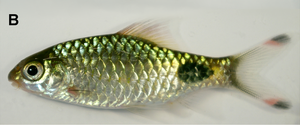Dawkinsia assimilis
| Dawkinsia assimilis | ||||||||||||
|---|---|---|---|---|---|---|---|---|---|---|---|---|

Dawkinsia assimilis |
||||||||||||
| Systematics | ||||||||||||
|
||||||||||||
| Scientific name | ||||||||||||
| Dawkinsia assimilis | ||||||||||||
| ( Jerdon , 1849) |
Dawkinsia assimilis ( Syn .: Puntius assimilis ) is a freshwater fish from the carp family (Cyprinidae). The species was in 1849 by the British physician, zoologist and botanist Thomas C. Jerdon as systomus assimilis described . The type locality is near Madikeri in the Indian state of Karnataka . The species is endemic to the Western Ghats and, apart from the type locality, was only found in the Nethravati River in Coorg (Karnataka), in the Bhavani River near Mettupalayam ( Tamil Nadu ), in the Chalakudy River near Vettilapara and in the Kallada River inFoundnear Thenmala in Kerala .
features
Dawkinsia assimilis becomes 11 cm long and has a body that is typical of barbels and is moderately elongated and laterally flattened. It differs from other species of the genus Dawkinsia by a combination of the following features: On the upper and lower section of the forked caudal fin there is a black band that is as wide as the diameter of the eye. The band is only weak or not at all developed in specimens from the Kallada River. On the tail fin stalk behind the beginning of the anal fin is a black spot that extends over two to five scales. Before the beginning of the anal fin, there are no pronounced spots on the body. In adult males from the Chalakudy and Kallada Rivers, the branched rays of the dorsal fin are elongated like filaments. From the black-spotted barb ( Dawkinsia filamentosus ) they can be seen through the lower mouth and the longer upper jaw barb. In Dawkinsia assimilis the barbels reach 23.5 - 33.3% of the head length (vs. 2.8 - 8.1% in D. filamentosus ).
Dawkinsia assimilis lives in slow-flowing waters with muddy bottoms as well as in relatively current-rich, clear sections of water with stony bottoms.
The IUCN classifies the species as Vulnerable , as all four local populations are threatened by pollution and uncontrolled fishing for aquarium purposes.
literature
- Rohan Pethiyagoda, Maurice Kottelat : A review of the barb of the Puntius filamentosus group (Teleostei: Cyprinidae) of southern India and Sri Lanka. Raffles Bull. 2005 Supplement No. 12: 127-144 PDF
Web links
- Dawkinsia assimilis on Fishbase.org (English)
- Dawkinsia assimilis in the endangered Red List species the IUCN 2011. Posted by: Raghavan, R., 2011. Accessed June 26, 2012th